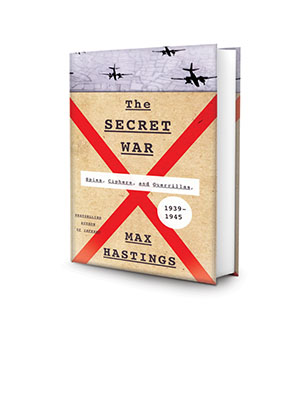T he outcome of World War II was determined in no small part by men and women who never fired a shot. Many were industrial workers who forged America’s Arsenal of Democracy. Their achievements are readily apparent, even if not always trumpeted.
he outcome of World War II was determined in no small part by men and women who never fired a shot. Many were industrial workers who forged America’s Arsenal of Democracy. Their achievements are readily apparent, even if not always trumpeted.
Mostly fascination, rather than fact, still surrounds World War II espionage agents and code-breakers, not least because contemporary descendants of organizations they once worked for still cling to secrets with long-expired shelf dates.
With a lot of archival information under lock and key, World War II spycraft history leans on sources where the lines between truth, speculation, and fabrication are readily breached. However, British journalist and author Max Hastings has written The Secret War: Spies, Ciphers, and Guerrillas. It is a well-crafted, reasonably comprehensive, impeccably researched, and humor-leavened account of both Allied and Axis World War II backstage intrigue.
The Secret War fills a big narrative tent—a sort of three-ring circus in which different types of attractions compete for attention. Human intelligence (HUMINT) and signals intelligence (SIGINT) occupy two rings. Partisan warfare, the third ring, is more of a sideshow, perhaps because, as Hastings argues, its moral impact far exceeded its military achievements. Altogether, the book is well worth the price of admission.
While Hastings downplays or rethinks many oft-told HUMINT stories, he delivers new gems, most notably Ronald Seth, aptly code-named “Blunderhead,” a fascist-leaning British agent who successfully deceived both sides. In the SIGINT realm, Hastings gives ample credit to the cracking of Enigma; but he also considers the breaking of Germany’s Lorenz teleprinter, a device that “conveyed the most important messages,” as comparably essential.
Intelligence agencies spared no expense even though secret information rarely affected battlefield outcomes. That said, when SIGINT or HUMINT succeeded, the result was so incalculably valuable that the overall cost was justified. The United States’ expenditures on SIGINT averaged $500 million annually between 1942 and 1945. Yet, says Hastings, “this has been justly described as its most cost-effective investment of the conflict.”
The Secret War is replete with lessons that resonate today. One is that “hard power”—the ability to mobilize superior ground, air, and sea forces—is essential. Without it, intelligence, no matter how timely and vital, simply cannot be exploited. Another is that democracies seem better equipped to exploit intelligence than authoritarian societies. They tend to appreciate the merit of truth and are more willing to employ their most diverse and cleverest minds. Stalin mobilized the most effective spying apparatus of the war, yet his all-consuming paranoia undid much that it produced.
—Historian and former U.S. Navy officer David Sears is the author of November/December 2016 issue’s “Death and Salvation on the Aluminum Trail.
This story was originally published in the November/December 2016 issue of World War II magazine. Subscribe here.





